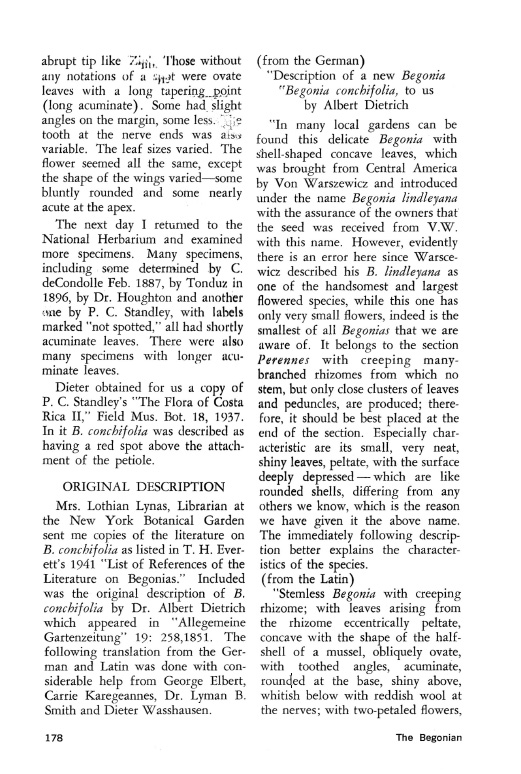Je n’ai aucune information à propos de la découverte de cette plante. Les spécimens auxquels s’est référencé Vellozo restent inconnus.
Plante dénommée par le botaniste brésilien José Mariano da Conceição Vellozo dans Florae Fluminensis Icones, edidit Domnus Frater Antonius de Arrabida. Parisiis volume 10, planche 50 en 1827 (mais publié le 29 Octobre 1831).
Son épithète spécifique vient du latin acetosus et signifie « vinaigré » par référence à la légère acidité du goût du feuillage quand on le consomme.
Cette espèce fait partie de la section Pritzelia.
![]()
Plus tard en 1881, la plante a été décrite dans les Archivos do Museu Nacional do Rio de Janeiro, volume 5, page 406.

Jack Golding lui a consacré un article très complet en 1996 dans The Begonian N° 63 pages 49 à 51.
Cette espèce a été introduite en 1946 aux USA par Mulford B. Foster qui l’avait récolté près de Rio de Janeiro. Suite aux recommandations de Jack Golding elle portait précédemment la référence Begonia U254. En effet, à la lecture de la description originale, plutôt maigre, de Vellozo, il avait visualisé un grand bégonia ressemblant à une canne à très grandes feuilles, qui ne correspondait aucunement à cette plante prostrée. Je ne connais pas de nouveaux spécimens de B. acetosa prélevés dans la nature ces dernières années. Les plantes que nous cultivons sont apparemment des clones de la plante apportée par Foster en 1946 des tropiques américains. A ce moment-là, il avait été identifié par le Dr. Lyman B. Smith comme étant Begonia acetosa Vellozo.

C’est un bégonia rhizomateux et très décoratif au port étalé et tombant, feuilles arrondies et veloutées, bords ciliés, tiges brun rouge. Le dessus du limbe est vert olive et est recouvert de poils blancs lui donnant un aspect velouté caractéristique, le revers des feuilles et brun-rouge foncé. L’inflorescence présente des fleurs blanches des deux sexes.
Cette espèce a été utilisée en 1986 par Ross Bolwell dans un croisement B. (soli-mutata x acetosa) qui ne semble pas avoir été suivi d’un franc succès.
La plante a également été utilisé pour créer les cultivars : B. ‘Black Raspberry’ (Paul P. Lowe, 1972) ; B. ‘Carolina Moon’ (Kit Jeans, 1977) ; B. ‘Christmas Theme’ (Sherer, 1960) ; B. ‘Holley’s Blues’ (Freda Holley dans les années 2000) ; B. ‘Laura Jane’ (Louise Schwerdtfeger, 1957) ; B. ‘Old Woman’ (Bob Cole, 1980) ; B. ‘Sunkist’ et B. ‘Trycola‘ (Hazel Burley – Australie) ; B. ‘Tuti Siregar’ (Hartutiningsih-M. Siregar – Bogor Botanical Gardens, Ouest Java, 2005) ; B. ‘Venice’ (Elsie Frey, 1957) ; B. ‘Yorke’s Delight’ (Bernard Yorke , 1980).
.

La plante prospère sous une lumière peu abondante, sans soleil direct et dans une terre moyennement humide et même presque sèche en hiver, pour un repos plus marqué, mais dans une ambiance humide.
C’est une plante assez commune en culture qui reste délicate à conserver en hiver sous nos climats.
Multiplication par bouture de rhizome, ou mieux, par semis qui est très facile à réussir.















I have no information about the discovery of this plant. The specimens referred to by Vellozo remain unknown.
Plant named by the Brazilian botanist Jose Mariano da Conceição Vellozo in Florae Fluminensis Icones, Edidit Domnus Frater Antonius de Arrabida. Parisiis volume 10, plate 50 in 1827 (but published on October 29, 1831).
Its specific epithet comes from the Latin acetosus and means « vinegar » by reference to the slight acidity of the taste of the foliage when it is consumed.
This species is part of the section Pritzelia.
Later in 1881, the plant was described in the Archives of the National Museum of Rio de Janeiro, Volume 5, page 406.
Jack Golding devoted a very complete article in 1996 in The Begonian N ° 63 pages 49 to 51.
This species was introduced in 1946 in the USA by Mulford B. Foster who harvested it near Rio de Janeiro. Following the recommendations of Golding she previously carried the reference Begonia U254. In fact, after reading Vellozo’s rather lean description, he had visualized a large begonia looking like a cane with very large leaves, which did not correspond to this prostrate plant. I do not know any new specimens of B. acetosa taken from the wild in recent years. The plants we grow are apparently clones of the plant brought by Foster in 1946 from the American tropics. At that time, he had been identified by Dr. Lyman B. Smith as Begonia acetosa Vellozo.
It is a rhizomatous and very decorative begonia with spreading and falling habit, round and velvety leaves, ciliate margins, red-brown stems. The upper limb is olive green and is covered with white hairs giving it a characteristic velvety appearance, the underside of the leaves and dark brown-red. The inflorescence has white flowers of both sexes.
The plant thrives under scanty light, with no direct sun and in a moderately humid soil and even almost dry in winter, for a more pronounced rest, but in a humid atmosphere.
It is a fairly common plant in culture that remains delicate to keep in winter in our climate.
Multiplication by rhizome cutting, or better, by sowing which is very easy to succeed.
This species was used in 1986 by Ross Bolwell in a B. (soli-mutata x acetosa) cross, which does not seem to have been followed by much success.
The plant has also been used to create the cultivars: B. ‘Black Raspberry’ (Paul P. Lowe, 1972) ; B. ‘Carolina Moon’ (Kit Jeans, 1977) ; B. ‘Christmas Theme’ (Sherer, 1960) ; B. ‘Holley’s Blues’ (Freda Holley dans les années 2000) ; B. ‘Laura Jane’ (Louise Schwerdtfeger, 1957) ; B. ‘Old Woman’ (Bob Cole, 1980) ; B. ‘Sunkist’ et B. ‘Trycola‘ (Hazel Burley – Australie) ; B. ‘Tuti Siregar’ (Hartutiningsih-M. Siregar – Bogor Botanical Gardens, Ouest Java, 2005) ; B. ‘Venice’ (Elsie Frey, 1957) ; B. ‘Yorke’s Delight’ (Bernard Yorke , 1980).
.























































